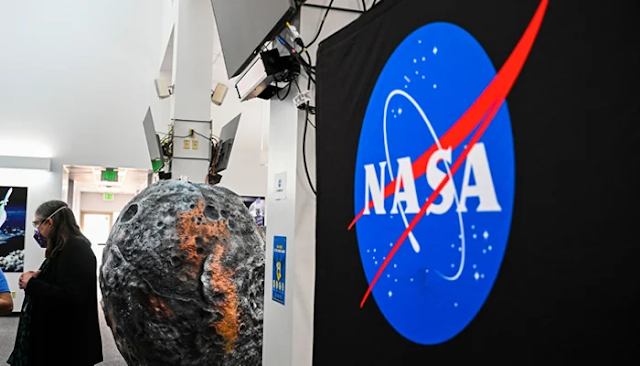NASA Mission to Fly Metal-Rich Asteroid to Probe Genesis
NASA, in collaboration with Elon Musk's SpaceX, is set to embark on an ambitious mission to explore and unlock the secrets of the cosmos. The joint endeavor is poised to rewrite the history of space exploration, taking aim at a metal-rich asteroid to probe its origins and shed light on the genesis of our universe. Scheduled for launch from the Kennedy Space Center at 10:19 am Eastern Time on Friday, this mission is a testament to human ingenuity and technological advancements in space exploration.
The Asteroid Destination
The primary target of this groundbreaking mission is a metal-rich asteroid called Psyche 16, orbiting the Sun between Mars and Jupiter in the asteroid belt. Measuring about 140 miles (226 kilometers) in diameter, Psyche 16 is primarily composed of metallic iron and nickel, which makes it a unique and alluring celestial body. The mission's name, 'Psyche,' is derived from ancient Greek mythology, signifying the exploration of the human soul or, in this context, the origin of planetary bodies.
Genesis and Psyche 16
The primary objective of the NASA Psyche mission is to gain unprecedented insights into the formation of planetary bodies, focusing on the hypothesis that Psyche 16 might be the exposed core of an early, protoplanetary body. By studying the metallic makeup of this asteroid, scientists hope to unveil crucial information about the building blocks of our solar system. Understanding the composition and structure of Psyche 16 can potentially provide answers to some of the fundamental questions about the creation of the Earth and other rocky planets.
NASA's Psyche spacecraft
The spacecraft chosen to undertake this historic mission is the Psyche spacecraft, designed and built by NASA's Jet Propulsion Laboratory (JPL) in collaboration with experts from various fields. The spacecraft will carry a suite of scientific instruments, including a gamma-ray and neutron spectrometer, a magnetometer, and multispectral imagers. These instruments will allow scientists to analyze and map Psyche's surface, its magnetic field, and composition in high detail.
SpaceX's Role
SpaceX, under the guidance of Elon Musk, is facilitating the launch of the Psyche spacecraft aboard a Falcon Heavy rocket. The Falcon Heavy, known for its significant payload capacity, is well-suited for transporting the spacecraft on this challenging journey. This partnership showcases the synergy between the public and private sectors in advancing space exploration, where NASA leverages the innovation and efficiency of private space companies.
Scientific Goals
The Psyche mission aims to address several key scientific questions:
1. What is Psyche Made Of? - Scientists want to determine the exact composition of Psyche 16, especially the proportion of metal versus silicate material.
2. Is it the Core of a Planetesimal? - The mission will explore whether Psyche is indeed the exposed core of a planetesimal, which would provide insights into the processes involved in planet formation.
3. What Role Did Water Play?- By studying the asteroid's surface, scientists aim to understand the role of water and other volatiles in the early solar system's development.
4. Was There Differentiation? - The mission will investigate whether Psyche underwent differentiation, a process where dense materials sink to a body's core, while lighter materials rise to the surface.
The upcoming NASA Psyche mission, with SpaceX as its launch partner, represents a remarkable step forward in our quest to comprehend the origin and evolution of our solar system. The exploration of the metal-rich asteroid Psyche 16 is expected to provide valuable data that may revolutionize our understanding of planetary formation and offer a glimpse into the very genesis of our universe. This joint endeavor, combining the resources and expertise of NASA and the innovation of private space enterprise, exemplifies the remarkable potential of public-private partnerships in space exploration. As the spacecraft sets out to probe Psyche, it carries with it the hopes and curiosity of a planet eager to unlock the secrets of its cosmic origins.



Comments
Post a Comment